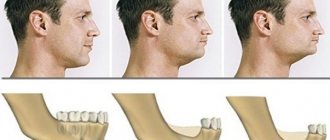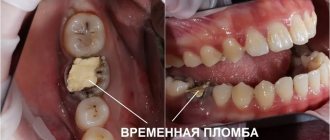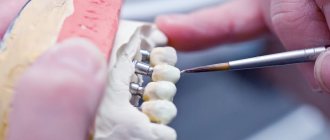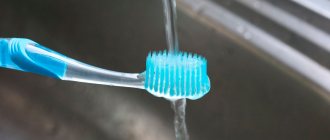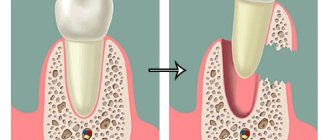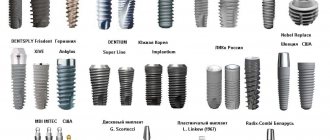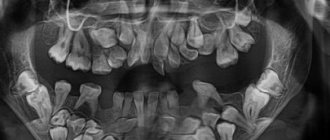The quality of therapeutic dentistry has increased over the past few decades, due to the development of technology. Despite the use of modern safe methods of dental treatment, there is a need for their removal. The wound heals quickly, but its consequences make themselves felt over a period of time. Many patients complain about aesthetic problems, they try to smile less, and are embarrassed to open their mouth. The absence of teeth leads to a redistribution of the load on the jaw, deformation of the dentition and aggravation of dental problems. For this reason, tooth extraction requires intervention; installing a prosthesis in its place will eliminate all problems.
Dental drainage: what it is, what it looks like
What is tooth drainage? Translated from English, “drain” means “to drain.” This is a medical instrument or device, the main purpose of which is the continuous removal of liquid contents from inflamed tissues and cavities. Usually it is inserted into open wounds and left for a short time, thus, with its help, a procedure is carried out that promotes the outflow of pus, serous exudate, blood and ichor.
This device was first invented by a French surgeon. It was originally created from materials such as glass and rubber. Today, lighter, softer and smoother materials are used for manufacturing: rubber, silicone and latex - they do not get wet, are well fixed and hold, and do not cause significant discomfort.
If you want to know what dental drainage looks like, look at the photo below. This device looks like a small thin tube, and in some cases it even looks like a thin wire, tape or just a strip of material. The device has different sizes and diameters.
The drainage system is installed in stages:
- The painful area of the jaw is numbed.
- The gum is cut and a latex drain is inserted into it, through the hole of which the pus is sucked out.
- After suctioning out the pus, an antiseptic drug is injected into the gum incision.
- If a tooth is removed, the gum is not cut, but a drain is inserted into the socket.
How many days should I wear the drainage? Improvement may occur within 24 hours. On average, drainage costs from 3 to 5 days.
Indications for installing the system in the gums
Let’s take a closer look at who gets drainage and why. Many patients consult a doctor with an acute inflammatory process and severe swelling of the tissues of the oral cavity (and sometimes even the face), caused by advanced diseases and accompanied by the appearance of a lump or abscess on the gum.
In this case, it is simply necessary to resort to surgical measures, namely, to cut the inflamed gum, as well as the abscess, and release its contents. To prevent the wound from quickly overgrown again, and to prevent pathogenic contents from remaining and accumulating inside it again, specialists place a drainage on the tooth.
So, the main indication for installing the device: a purulent-inflammatory process in the mouth caused by pathologies such as advanced pulpitis and periodontitis, gumboil, fistula, abscess, cyst and granuloma. A wide opening of the purulent cavity and drainage of pathological foci are also carried out in such serious diseases as odontogenic osteomyelitis and phlegmon [1], when the bone structures of the jaw and soft tissues of the face are affected.
On a note! The procedure is contraindicated in patients with bleeding disorders and allergies to painkillers used during the operation and the incision on the gum.
Prosthetics after tooth extraction and indications for the procedure
Installation of a denture allows you to completely restore the functional and aesthetic properties of the jaw apparatus. The indication for the procedure is single or multiple damage to the jaw as a result of trauma, surgical amputation due to advanced caries, or other diseases of the oral cavity.
If the crown is partially destroyed, a microprosthesis is installed instead of the usual one. This group includes inlays, veneers and ultraneers. The products effectively solve aesthetic problems with minimal trauma to natural bone and gum tissue.
Drainage of the hole after the root removal procedure
Separately, it is worth mentioning situations when drainage is installed and the socket of an extracted tooth is drained. The procedure is indicated in the following cases:
- immediately after removal of a neglected and irreparable unit that has caused the appearance of an abscess in the oral cavity: if the manipulation is not performed, the likelihood of developing postoperative complications increases,
- drainage in the gums after tooth extraction is a mandatory treatment measure for those patients who have developed purulent complications during the rehabilitation period: alveolitis, gumboil, abscess,
- drainage is often installed after the removal of a wisdom tooth, and this is done to directly administer medications into the wound, which ensures rapid tissue healing and, of course, minimizes complications.
Features of the procedure
Let's take a closer look at how drainage is placed on a tooth. The procedure includes several important steps.
Stage No. 1
First, the specialist conducts a thorough visual and x-ray examination of the inflamed area to get an accurate idea of the location of the abscess, its size and depth.
Stage No. 2
The doctor administers local anesthesia so that the patient does not experience pain during the procedure. Next, at this stage, surgical intervention is performed.
If the tooth next to which the abscess has appeared can still serve, then the specialist cuts the inflamed gum with a scalpel. In cases where saving the tooth is not practical, the dentist removes its root, after which he places a tube to drain the fluid directly into the open socket (in this case, no tissue incision is made).
Stage No. 3
The opened purulent cavity is thoroughly cleaned, treated with antiseptic solutions, after which drainage is fixed in it. One end of the device is inside the wound, and the other is outside.
Next, the doctor prescribes medications, antiseptic rinses and antibiotics for home use, which, together with the installed device, will work to quickly eliminate the inflammatory process and normalize the patient’s condition.
Feelings after installation
Experts say that if the device is installed correctly, it should not cause any discomfort. Yes, its presence in the mouth can be felt by directly touching it with your finger or tongue. But the drainage in the tooth should not cause pronounced discomfort, rub the mucous membrane and get in the way. It is normal and correct if liquid is constantly released through it.
If you have a tooth removed and drainage installed, the sensations will, of course, be more pronounced. After all, you have undergone a full-fledged surgical operation, after which swelling, pain, a slight increase in body temperature, and difficulty opening your mouth are possible. However, all these symptoms are, to a large extent, just normal consequences of extraction (removal). But in some cases they can indicate serious complications. How to separate normality from pathology? The answer to this question is in the feature article on the site.
Implantation of artificial teeth
A modern, long-lasting option for the restoration of front teeth is implantation. This operation involves inserting a special pin into the jaw bone, in the place where a tooth is missing, which will act as a tooth root and will counteract atrophic changes in bone tissue. This pin is made of titanium and does not cause any inconvenience or complications in the future. Then a crown made of ceramic is installed on this titanium rod. Implantation makes it possible not to touch the healthy teeth in the neighborhood. For this procedure, high-quality durable implants from the Nobel Biocare brand are used, which are guaranteed for life. The implanted tooth will not differ in any way from the rest, since the crown is made after measurement and exactly matches the shape and natural shade of the teeth. Another technique for using dentures on the front teeth is installing a bridge.
The name “bridge” was borrowed from technicians, since its installation uses the principle of constructing bridges. A bridge is a type of permanent dental prosthesis; they are used to replace defects of several teeth (up to four) in a row. To do this, special crowns are installed on the adjacent good teeth, between which the prosthesis will be placed. The negative quality of this technique is the need to grind down the surface and remove the pulp of healthy teeth on which crowns will be placed. The bridge also needs to be replaced at least once every few years. But with these disadvantages, this method allows you to avoid surgical intervention.
Duration of treatment
Many patients are interested in how long tooth drainage costs. On average, it is left for 3-6 days. During this time, all pathogenic fluid should completely leave the wound. If all is well, the patient usually feels relief within 24 hours after installation. With each subsequent day, positive dynamics are observed, swelling subsides and disappears, and the color of the mucous membrane normalizes.
It also happens that after this period, unpleasant symptoms of the disease persist, which means that the inflammatory process continues. Then doctors conduct a new examination, adjust treatment tactics and resort to other measures.
If there is drainage after tooth extraction, when can it be pulled out? The doctor decides. If the dynamics are positive, the tube is removed after 3-4 days. When the inflammatory process persists or complications of extraction appear (for example, alveolitis), the specialist pulls out the tube, performs a thorough curettage, that is, cleaning the hole, after which he can reinsert the device.
Stages of treatment
The duration of one-stage implantation is about 4-6 months. Restoration of bone tissue after tooth extraction is not required; bone tissue augmentation as a separate procedure is also not performed. Therefore, after installing the implants, a temporary prosthesis is immediately fixed, and after a few months, when the implants and bone tissue have completely fused, a permanent dental crown is installed.
Galina Vladimirovna, 57 years old
“I had my natural teeth removed and implants were immediately placed. Within a week my smile was back. I really like the way I look and the way I talk. My diction hasn’t changed, I’m comfortable. I am very pleased and grateful to the doctors!”
- we give SMILES, HEALTH and new LIFE
- smile and enjoy every day
- start CHEWING immediately
- forget about the unpleasant smell and pain
- complete the entire treatment in a WEEK
watch a video with the patient
Preparation for implantation (from 2 days to 2-3 weeks)
When a tooth is removed and an implant is installed at once, sometimes there is very little time left to prepare for treatment, since most often teeth that are in very poor condition have to be removed. However, implantologists pay great attention to this stage, since it is necessary to conduct a thorough examination of the patient’s oral cavity and body, to exclude possible contraindications that could cause rejection of the structure.
Preparation for immediate implantation is absolutely standard and includes taking a series of blood tests, taking an X-ray or panoramic photo of the jaw, as well as dental treatment and removal of deposits. If there are acute problems with the body, we can refer the patient to an appointment with a highly specialized doctor to clarify the diagnosis, assess the state of health and carry out appropriate treatment
Installation of implants and bone grafting (1-2 hours)
Installation of an implant with simultaneous tooth extraction is carried out in a fairly simplified form: additional tissue incisions and bone drilling are not required to form a bed for the implant. The tooth is removed from the socket as carefully as possible, with minimal trauma to the bone tissue. Next, the cavity is thoroughly sanitized. If necessary, an x-ray is prescribed so that you can make sure that the cavity is empty and there are no pieces of instruments or parts of the tooth left inside it. Next, a dental implant is fixed in the hole, and the space around it is sprinkled with artificial bone tissue. The gums around the implant are sutured.
Temporary prosthetics (3-6 months)
Depending on the initial situation, both one-piece and two-piece implants can be used for simultaneous implantation. Both of them can be instantly loaded with a temporary prosthesis.
Three types of structures can be used as temporary dentures (they are selected based on the quality of bone tissue, the degree of primary fixation of the dental implant and the number of missing teeth):
- removable immediate denture (for front and side teeth),
- lightweight plastic crown (only for front teeth with single restorations),
- acrylic prosthesis with plastic crowns (with complete edentia).
A resin crown is created that is slightly shorter in length than the adjacent teeth in the row. This allows you to significantly reduce the load on the prosthesis, and hence the implant itself. At the same time, the appearance of the smile is maintained at the highest level. From the point of view of further aesthetics, a single crown is a more preferable option for single restorations, since it allows you to shape the position of the gums.
It is important! Installation of a single crown is possible only on single-rooted teeth, which do not bear much pressure, and they mostly perform aesthetic functions - these are incisors and canines. If you chew food with the restored tooth, the implant simply will not take root, since it will shift due to the load.
In case of complete edentia, when it is necessary to restore the entire dentition, several implants are installed at once. If there are teeth that need to be removed, some of the implants can be fixed into their sockets. In this case, a fixed prosthesis with a metal base, acrylic base and plastic crowns is fixed on top. It firmly connects all installed implants, which prevents them from moving. Read more about immediate loading methods >>>
Permanent prosthetics (1-2 weeks)
Permanent prosthetics are the final stage of treatment. It can be started only after the doctor is convinced that the implants have completely fused with the bone tissue - measurements are carried out with special devices and x-rays.
The temporary crown is removed, impressions are taken - the data is transferred to a dental laboratory, where an individual prosthesis is created. The dental technician must take into account the position of neighboring and antagonist teeth located on the opposite jaw. The manufacturing process takes about 1-2 weeks.
Metal-ceramics or zirconium can be chosen as materials for permanent dentures - these crowns are more aesthetic, stronger and more durable.
Advantages of the method
- shortened treatment times,
- no bone grafting required
- instant restoration of aesthetics,
- no bone tissue augmentation is carried out,
- lower cost of treatment,
- The service life of installed implants is more than 20 years.
Disadvantages of the method
The only disadvantage of one-step implantation is that it is not always possible to carry out it. You need to prepare for treatment: assess the condition of the body, exclude contraindications, select an implant model depending on the volume and quality of bone tissue. But the removal of your own tooth quite often has to be done urgently, which does not make it possible to conduct a full examination and understand whether it is possible to install an implant at the same time.
Rules to follow when having a device in your mouth
Anyone who has had drainage installed after a gum incision or tooth extraction needs to know how to behave during this period. Doctors give the following recommendations:
- you need to follow a certain diet: it is forbidden to eat hot and hard foods and chew on the side of the jaw where the intervention was performed. You need to give preference to soft and liquid dishes, drink more clean water,
- It is undesirable to sleep on the cheek on which the device is installed,
- Brushing your teeth should be done extremely carefully, avoiding the area where the tube is located: for hygiene, you can use a brush with soft bristles and a non-abrasive toothpaste. It is better to avoid using an irrigator for a while,
- Intensive rinsing of the mouth is prohibited: to carry out antiseptic and disinfectant procedures, simply take liquid into your mouth, hold for 2-3 minutes, spit it out,
- It is important to protect yourself from physical activity and sports.
What to do if the device falls out
Some patients do not even have time to find out how the tooth drainage is removed at the dentist, because the tube itself falls out of their mouth. What to do in this situation? If the system falls out in the first few days after the procedure, then you need to quickly contact your doctor to have it reinstalled. During this period, the likelihood that all the pus has come out is still too small, and the wound will heal very quickly, accordingly, pathogens will remain inside it.
If the device falls out 4-5 days after the procedure, and you notice that the swelling has subsided and pus is no longer oozing from the wound, then there is nothing to worry about. In this case, we can assume that the drainage installed for the treatment of various dental pathologies and after tooth extraction has successfully fulfilled its purpose. However, you still need to see a doctor.
Important! The main reasons for premature loss of the device: improper oral hygiene technique, active rinsing, violation of the postoperative regimen, poor-quality installation of the tube in the dental office.
Expert opinion
Elena Vladimirovna Orlova
Specializations: Dentist-therapist, endodontist
Experience: 33+
“Under no circumstances should you install drainage on a tooth yourself. You can injure the tissues or, even worse, introduce an infection into them, after which the inflammation will flare up with renewed vigor. All procedures for its installation and removal must be carried out by professional doctors under completely sterile conditions."
Prosthetics on implants
This method is good because it can be used when one or more teeth are missing. In case of complete edentia, it is also used, but there is no talk about preparation. A metal pin is inserted into the place of the lost tooth, and dentures are put on it, without grinding the adjacent teeth.
What are the advantages:
- neighboring teeth are not affected and remain “alive”;
- the number of artificial teeth can be any;
- the method is used to restore anterior and chewing teeth;
- the implant prevents bone tissue atrophy;
- Implants come with a lifetime warranty.
For prosthetics on implants, you can use any of the following methods:
- Removable prosthetics
A removable denture is attached to part of the jaw or to the entire dentition much better than on natural teeth. Removable structures do not fall out arbitrarily, but the patient is able to remove them himself for hygiene procedures. Conditionally removable ones are secured with screws; only a dentist can remove them.
- Fixed prosthetics
The classic bridge design has proven its effectiveness. This is a reliable way to restore your teeth. When attached to implants, all the disadvantages disappear: dentures are without grinding, which means there is no need to depulpate the supporting teeth. The metal pin is stronger than the natural root, the design will last for many years. Implants prevent bone tissue from resorption. There are no restrictions in the choice of materials for crowns, and the number of artificial teeth can be more than 2
.
Unfortunately, sometimes there are contraindications to installing implants. In such cases, other prosthetic methods are used without turning adjacent teeth.
Self-removal of the structure: possible or not
Some patients experience severe discomfort, so they are interested in how to remove drainage from a tooth on their own. Others do not have time to make an appointment with a doctor on time, so they also want to know the answer to this question. Often, the dentists themselves provide detailed instructions so that the patient can perform the procedure at home. The procedure should be as follows:
- wash thoroughly with soap and disinfect your hands,
- treat the oral cavity with some antiseptic: Miramistin, Chlorhexidine are suitable,
- stand in front of the mirror, open your mouth, carefully grab the tip of the tube protruding from the wound with your thumb and forefinger and pull it towards you without force,
- rinse your mouth with an antiseptic,
- Do not consume food or drink for the next 2 hours.
“On the eve of the New Year holidays, I had a drainage installed after the removal of a dental cyst. The procedure is painless, as it is under anesthesia, but the doctor said that due to the holidays, I will have to pull the tube out of the wound myself in four days. I described in detail how this is done. When the hour struck, I was very worried, I thought it was difficult, but in fact I did everything quickly. However, after ten minutes the pain was so severe that I had to take pills. But within a day I even forgot that I once had this tube. After the holidays, I saw the doctor, he said that I was good, and the tissues were healing normally!”
Irina R, review from 32top.ru
The procedure is simple, but if the device has not fulfilled its main purpose, then it should not be carried out under any circumstances. And, in general, even if your condition has improved significantly, you should not resort to independent measures without consultation with a specialist. It is better to have a professional doctor perform all steps to remove the device. Why? Removing the tube yourself can cause severe pain, prolonged bleeding, damage blood vessels and injure surrounding tissue.
